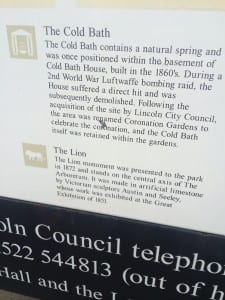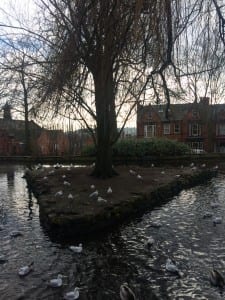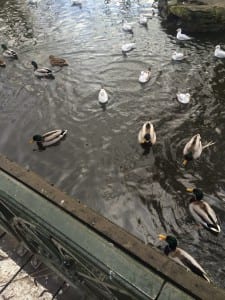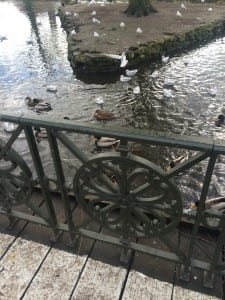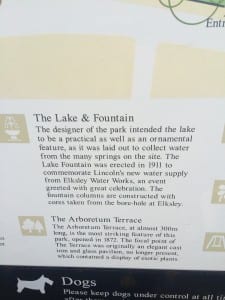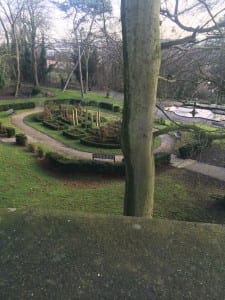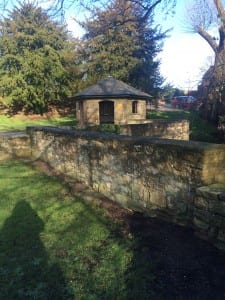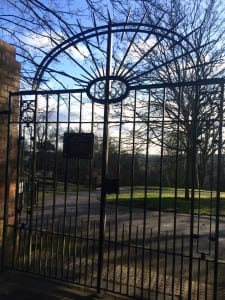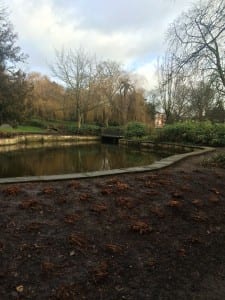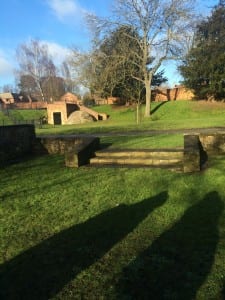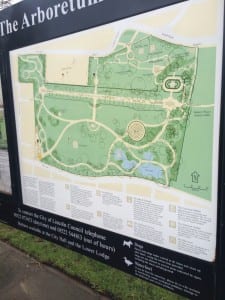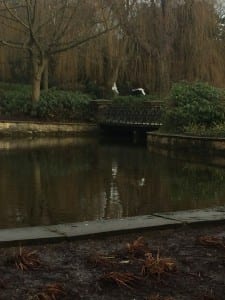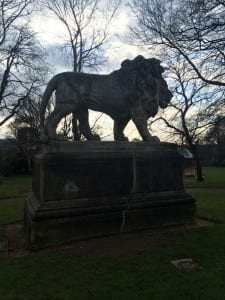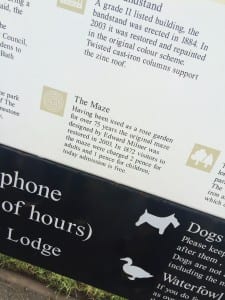Framing Statement
Overall our performance process as a whole was long, very long. We found ourselves going round in circles, ironic because our piece is set on the cyclical set of time, but as a group we definitely tired ourselves out. It personally took me a few weeks to be able to come to terms with thinking outside the box and being able to deal with so much freedom in one piece. Our main research came from the history of the park more specifically The Cold Bath House and the World War Two history within the park. We also researched deeper into the Cold Bath House finding an 1891 census (It’s About Lincoln, 2013) and a retell of events from a male who had been present the day the House had been bombed in World War Two. (BBC, 2005) Our first idea was to create a story of a couple and their family saying goodbye before war and to have a young sister lead the audience but after discussing our idea with Karen we realised the piece was too literal, did not feel site specific and also felt that we were more focussed on the idea of the characters instead of the space; we had not let the space create our ideas. We also realised we would not be able to make the audience feel completely in the past due to us being unable to change the space itself and because the park was not private, there would be a high chance of the public walking through which would have broken the illusion. We then began discussing the element of time within our piece, especially when in discussion with the door we had decided to begin our performance at. ‘The Timekeeper’ by Mitch Albom was another stimulus for us and we decided to use a passage from this book within our piece. We wanted the audience to think about the passage of time and question how little they actually thought about time throughout their everyday life. Punchdrunk’s ‘The Borough’ was also a big influence in our performance with the use of a backing track as well as our recorded script for each character. Our performance started at the door just outside the Arboretum, and then the audience are led towards where The Cold Bath House would have been before it got destructed, the audience are then guided through the park by the audio piece they are given at the beginning of the route. By using the census we created characters throughout the park that the audience meet and learn some of their past, I performed as George Smith, the gardener of The Cold Bath House. My performative action was to clean up the maze, I did this repeated over until the audience member had passed me, I then moved to the end point which was the steps in the centre of the park and joined the rest of the group.
Analysis of Process
We began with a drift though Lincoln which led us to the Arboretum. Once at the Arboretum we read the map board and found out there was once a Cold Bath House at the same place as the Arboretum which had been bombed in World War Two so we decided to use that as a stimulus for our performance.
This was because as a group we all had different ideas we felt we could bring together in to a strong group performance. Our first initial idea was for the audience to follow a young male and his journey as he left for war, they were to meet his girlfriend and two younger siblings whilst he said his goodbyes for war. We began recording audio to use as a backing track for our performance such as the birds, footsteps and the fountains. When walking around the space we took photos to document the points within the park where we felt the audience member would understand and feel the type of emotion we were portraying and also to keep the route natural and flowing. When we took Karen around the space and explained to her what we had planned she highlighted that we had thought too literal about the piece and had focussed mainly on the characters, therefore not making the piece site specific because of the lack of historical documentation as well as connection to the site: “Place has tended to exert a different kind of influence on the development of performance context, an influence more often abstract and imaginative than purely literal” (Wilkie, 2002, 156) It was also highlighted that it would be unable to fully create the illusion of being in the past due to us not being able to fully edit the space, with it being a public space with members of the public using it daily and around the time we would be performing.
We then decided to sit down as a group and re-evaluate our ideas. Whilst discussing different ideas we then got on to the subject of time in our piece, we knew we wanted the audience to travel on a journey and to think about how they use time in their daily lives. We then used Mitch Albom’s ‘The Timekeeper’ as a stimulus as we felt one of the opening passages fitted well in our piece. We decided to use this at the door after the Cathedral had chimed on the hour which led nicely in to the audience thinking about time and also give them a small idea of what was to come. This was the first half of our final product. The reason this was only half was due to me feeling the performance could connect with the site more. “A site brings its own historical, cultural or political implications, which are the interwoven with other concerns and aesthetics into the final piece” (Wilkie, 2002, 156) So I decided to research into the past of The Cold Bath House therefore finding the census and Fred Hurt’s story so by adding the use of historical documents and understanding the site’s history slightly deeper I felt our performance was a strong site specific piece and therefore was the performance was glued to our site; it would not work anywhere else. Although, this created a problem for the group as once I had done the research and we met as a group, it was difficult to link the two ideas together and we felt as a group it could become messy. Karen then gave us the option to split the group in to two smaller groups and have two different performances in the site but after a long discussion we decided to stay as one group but alter each idea slightly. By making both halves of the performance incorporate some element of time whether it was the seasons, the past, the future or present we managed to include each part we had wanted to. We used the census to create a short passage for Henry Hebb, who had The Cold Bath House built and George Smith, the gardener for the house. We also included the retell of events from Fred Hurt, as well as paragraphs forcing the audience to think and question their own use of time.
To fully connect the performance to the site, we also recorded the backing track audio we had at the park so when the audience were guided through the park they had the exact sounds they would have if they had simply been walking through the park naturally; we walked the route we had planned and recorded what we heard. As well as recording the simple bird track, we recorded the fountain, footsteps on the gravel around the maze and the chimes from the play park at the top of the Arboretum. We wanted to keep the backing track natural to give the feel of a natural and present essence even though they had people from the past talking to them as though they too were present. We had a lot of rehearsals and lessons in audacity which at first I found it really difficult but after much (!) perseverance I eventually managed to fully understand the software and often found myself offering to edit the piece alone due to other rehearsal and commitment clashes within the group. Once we had recorded and edited the birds, footsteps and fountain we then had to go back to the Arboretum to record even more such as the chimes from the play park. We also had to reroute the performance due to us changing the idea so we went back to the Arboretum to decide on this. Once we had written our monologues and passages of speech we spent a morning recording these in a studio before editing them in audacity.
After Easter, we realised we were quite behind and had still not finalised the timings for the audio track so we met as a group and rehearsed in the arboretum. We all walked the route we had planned with one of us listening to what we had recorded and another one of us timing the walk between each point we wanted the audience to stop at. Once we got the timings, we went back to the mac suite to edit this in to audacity. The layering of the piece was similar to Punchdrunk’s ‘The Borough’ by layering the track of the Arboretum along with our voices “There are worlds within worlds and layers within layers” (Gardner, 2013) as we twist in the use of the past world and the present world, joining them together and also the layering of the different elements and cycles of time as well as the layering of the audio.
We wanted the audience to feel natural in the space but also like they were watching the world going by; like they were in their own bubble. We decided to start at the door with one of the runners greeting the audience member, this was because the door represented new beginnings but also the past because it was worn and old, you could see where the ivy had grown up it but then also been ripped down; a great aesthetic. As well as this, we started at the hour in time with the Cathedral bells which connected with our theme of time and the cycle of it. The runner then left the audience member once they had begun the audio and let our audio track lead the audience. It first took them to Henry portrayed by Lee at the tree just outside one of the Arboretum gates, we wanted the audience to meet Henry first to lead the audience to where The Cold Bath House began, leading then to the play park where they meet Emma. We wanted the change in mood as they then moved on to the childhood past of their own, making the audience think of their beginning. The audience are then led to the ledge where they are told to look out across the arboretum and think about time; continuing onwards from the play park. They are then led down past the fountain where they see some runners; these runners are running laps and are also seen timing their run which again is a cycle and connection to time. The audio then leads the audience down some steps to the maze where they meet the Gardener portrayed by me. We had the gardener in the maze due to the idea of the being timed in a maze, the gardener also speaks of seasons; another element of time. Then finally the audience are led to the lion below the steps in the middle of the Arboretum which is when they listen to Fred’s retell of events from when the Arboretum got bombed where our audio tour ends. We wanted to end the piece in the centre of the park and on the stairs with the whole cast spread across them to show the audience the piece had ended, we felt it was a strong image and was also easier for the audience to see the exit.
As a group, we also wanted to take the audience on a journey through past and present again much like Punchdrunk’s ‘The Borough’ “Punchdrunk encourage you to look seawards, finding a place where the sky and sea, past and present, fact and fiction collide” (Gardner, 2013) we incorporated the fact of the names and occupations from the census with the fiction of the monologues themselves and the placement of the characters. We also wanted the audience to merge the use of time with the idea of time and why we stick to it when it is simply a man-made thing. We included many different cycles throughout the performance including the cycle of time and the cycle of the seasons also the joggers were jogging in a cycle and we included the cycle of life whilst at the park.
We met up before our final rehearsal to test the audio one more time and also to discuss the performative actions we were to do. We decided that Lee would continue to walk around the park drawing to show the audience what Henry would have done in the past, as the gardener I was to tend to the maze and watch the weather; much like the gardener would have done. Hayley and Sara were to jog in a cycle but at slightly different paces timing each other. On our final rehearsal one of our main worries was the weather. The week before our performance had been one of the hottest weeks in a long time so it was inevitable it was due to rain so as a group we made sure to take note to layer up on the day of our performance. Throughout our final rehearsal Sara decided to take the role of audience member and was led by our audio. We practiced our repetitive actions and also finalised the ending as we were unsure about timings of when to get to the steps for; we did not know whether it would look better if we arrived together or separately so this really helped us decide as she was able to tell us what it looked like from an outside eye. The final rehearsal ran smoothly and the weather was good for Britain…
Performance Evaluation
On performance day the weather was luckily on our side. As we only had two performances the rain stayed away both times and only down poured between the two. The final performances went a lot better than any of us expected due to us finding the module quite difficult and we were pleased with the feedback. I felt we had definitely grown as a group and our timings were really strong. I feel our weakest point was the ending, we could have edited the part at the steps as it felt, for me personally, a little messy. As well as this, Karen had to ask me where the lion was within the maze as due to the growth of the trees she was unable to see the lion from where she was standing, this was because we had set the route when the trees were not fully in bloom and also because we were so used to the route ourselves we completely forgot. Even though the audience numbers worked well with the weather I would have liked to have had a few more runs of the piece just to get feedback from people who were completely new to site specific and audio tours. In our feedback from Conan, he brought up that we could have invited the audience in to the maze which I thought was a great idea. We had previously thought about it but worrying about timing we decided against it. I think this would have added an extra depth to the performance and also linked again with our time theme; we could have given the audience member a certain amount of time to get out of the maze or allowed them to time themselves. Whilst in the site and stood in my position within the maze, I realised you was able to see so much even in such a restricted way. On realising this, I think if I was to add anything else to the performance it would be to get the audience member to come into the centre of the maze and look around the park. I would get them to think about the confinement they are in but that they are still able to see how open the space is, I would have linked this to time and the confinement of that and also how much freedom is in it too. Whilst working throughout this module, even though I found it challenging and at times frustrating, I think it has opened my mind to working in non-theatrical spaces and also using these spaces as stimuli for performances.
Works Cited:
It’s About Lincoln, 2013 Lincoln’s Smallest Parish [blog entry] 17 October. Lincoln. Available from https://itsaboutlincoln.wordpress.com/2013/10/17/lincolns-smallest-parish/ [Accessed 16 March 2015]
BBC(2005) WW2 People’s War [online] London:BBC Available from www.bbc.co.uk/history/ww2peopleswar/stories/10/a7503310.shtml [Accessed on 16 March 2015]
Wilkie, F. (2002) Mapping the Terrain: a Survey of Site-Specific Performance in Britain. New Theatre Quarterly, 18 (2) 140-160.
Gardner, L. (2013) The Borough – review. The Guardian. 11 June. Available from http://www.theguardian.com/stage/2013/jun/11/borough-review
